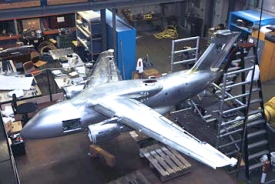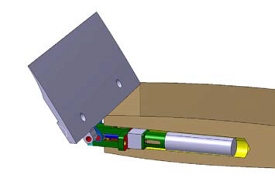
The Embraer KC390 with RCs
Lower costs yet more valuable measurements in wind tunnel tests
At NLR we develop Remote Controls for aircraft and engine manufacturers. When designing a new aircraft, first a mathematical model is made and Computational Fluid Dynamics (CFD) calculations performed. Thus the ideal aerodynamic shape of the airplane is determined. But aircraft manufacturers still need the CFD model to be validated through wind tunnel tests. When performing the wind tunnel tests, very often differences between the results of the CFD model and the measured values in the wind tunnel do occur. Nevertheless aircraft manufacturers need both methods to minimize development risks.
For wind tunnel tests a number of configuration modes are defined to be measured, different positions of control surfaces like rudders and flaps in various combinations. This can, for example, be six positions for every control surface. For all modes of the various control surfaces a so-called test matrix will be defined. During the measurements almost always unexpected phenomena do occur, which causes the aircraft manufacturer to adjust the test matrix by adding an extra step or intermediate position. Often they would like to see in more detail when a particular important aerodynamic phenomenon occurs.
To measure the various positions we use ‘brackets’. These brackets are made in advance and are all available when the wind tunnel tests begin. If during the tests additional positions need to be measured, very quickly new brackets are designed and manufactured so they can still be included in the running tests. This will still cost at least a few days, which customers generally accept in order to get the more valuable data.
For a configuration change, as defined in the test matrix, the wind tunnel has to be stopped each time, allowing the engineers to replace the brackets in the model. This stop-start process takes on average half an hour, will occur dozens of times during a wind tunnel campaign and is an integral part of the precious wind tunnel experiment time.

Demonstrator of the spoiler RC concept
Remote Control ensures that you do not have to stop-start the wind tunnel during the execution of the test matrix. The test can be performed uninterrupted, and additionally allows for measuring all intermediate values of the discrete steps that would have been measured with the brackets only. If during the test the need arises to adjust the test matrix, this can easily be accommodated from the control room and also needs no stop-start of the wind tunnel. This renders a three-fold yield: precious wind tunnel time can be reduced, much more valuable data will become available and the measurement matrix can be real-time adjusted during the measurements.
NLR has generic Remote Controls available for the following control surfaces: rudder, elevator, ailerons and the horizontal stabilizer. Spoiler Remote Controls are presently under development. Slats and flaps Remote Controls are planned for the longer term. Besides generic Remote Controls the manufacturing of specials is possible, like parachutes or refueling hoses.
The costs of installing a generic Remote Control will be around 3 k€, a specific one around 10 k€. Per control surface the wind tunnel has some 5-6 stop-start cycles, which takes 2.5 to 3 hours. This is wind tunnel time, yields no measurement results, and costs per control surface several tens of k€’s! So to save on wind tunnel costs and increase efficiency and flexibility of the measurements, Remote Controls are an indispensable component.
Also visit our wind tunnel models capability page.


